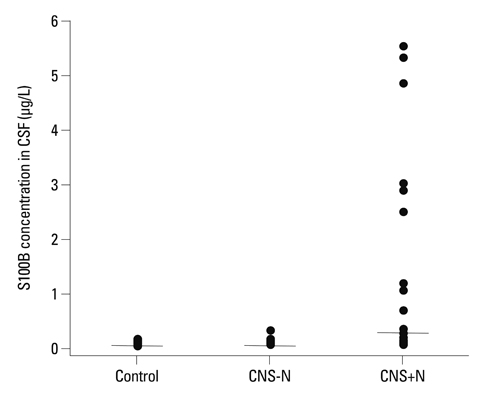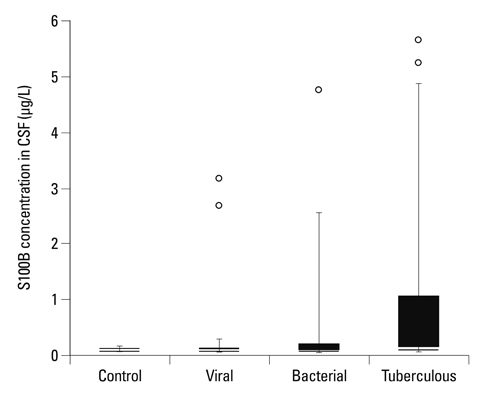Yonsei Med J.
2013 May;54(3):567-571. 10.3349/ymj.2013.54.3.567.
Association between Cerebrospinal Fluid S100B Protein and Neuronal Damage in Patients with Central Nervous System Infections
- Affiliations
-
- 1Department of Neurology, The Catholic University of Korea College of Medicine, Uijeongbu St. Mary's Hospital, Uijeongbu, Korea. alouet@catholic.ac.kr
- KMID: 1727865
- DOI: http://doi.org/10.3349/ymj.2013.54.3.567
Abstract
- PURPOSE
S100B protein is widely used as a measure of glial activity or damage in several brain conditions. Central nervous system (CNS) infections can cause neurological sequelae because of parenchyma invasion. It is difficult to predict further neuronal damage in the CNS infection. The present study is aimed to evaluate the role of the cerebrospinal fluid (CSF) S100B protein as an indicator of neuronal damage in CNS infection.
MATERIALS AND METHODS
We measured the concentration of CSF S100B protein in 62 patients with a CNS infection using an Enzyme-Linked Immunosorbent Assay. The patients with CNS infections were classified as having no neuronal damage (CNS-N) or as having neuronal damage (CNS+N) according to the presence of neurological change or structural lesions on brain MRI.
RESULTS
The CSF S100B protein level of the CNS+N group (n=22, 0.235 microg/L, 0.10-2.18) was significantly higher than that of the CNS-N group (n=40, 0.087 microg/L, 0.06-0.12) and control group (n=40, 0.109 microg/L, 0.07-0.14, p<0.01). Using an arbitrary cut off value, S100B-positive CSF was detected in 2.5% of the CNS-N group and in 50% of the CNS+N group (p<0.05).
CONCLUSION
These findings suggest that increased S100B protein levels in the CSF may be associated with the neuronal damage following CNS infections.
Keyword
MeSH Terms
Figure
Reference
-
1. van de Beek D, Schmand B, de Gans J, Weisfelt M, Vaessen H, Dankert J, et al. Cognitive impairment in adults with good recovery after bacterial meningitis. J Infect Dis. 2002. 186:1047–1052.
Article2. Schmidt H, Heimann B, Djukic M, Mazurek C, Fels C, Wallesch CW, et al. Neuropsychological sequelae of bacterial and viral meningitis. Brain. 2006. 129(Pt 2):333–345.
Article3. Kim MA, Park KM, Kim SE, Oh MK. Acute symptomatic seizures in CNS infection. Eur J Neurol. 2008. 15:38–41.
Article4. Rufa A, Cerase A, Annunziata P, De Santi L, Buccoliero R, Monti L, et al. Transient supranuclear paresis of the abduction in viral encephalitis of the brainstem. Neurol Sci. 2010. 31:653–655.
Article5. de Louvois J, Halket S, Harvey D. Effect of meningitis in infancy on school-leaving examination results. Arch Dis Child. 2007. 92:959–962.
Article6. Bedford H, de Louvois J, Halket S, Peckham C, Hurley R, Harvey D. Meningitis in infancy in England and Wales: follow up at age 5 years. BMJ. 2001. 323:533–536.
Article7. Donato R. S100: a multigenic family of calcium-modulated proteins of the EF-hand type with intracellular and extracellular functional roles. Int J Biochem Cell Biol. 2001. 33:637–668.
Article8. Böttiger BW, Möbes S, Glätzer R, Bauer H, Gries A, Bärtsch P, et al. Astroglial protein S-100 is an early and sensitive marker of hypoxic brain damage and outcome after cardiac arrest in humans. Circulation. 2001. 103:2694–2698.
Article9. Ingebrigtsen T, Romner B, Marup-Jensen S, Dons M, Lundqvist C, Bellner J, et al. The clinical value of serum S-100 protein measurements in minor head injury: a Scandinavian multicentre study. Brain Inj. 2000. 14:1047–1055.
Article10. Herrmann M, Vos P, Wunderlich MT, de Bruijn CH, Lamers KJ. Release of glial tissue-specific proteins after acute stroke: a comparative analysis of serum concentrations of protein S-100B and glial fibrillary acidic protein. Stroke. 2000. 31:2670–2677.
Article11. Wiesmann M, Missler U, Hagenström H, Gottmann D. S-100 protein plasma levels after aneurysmal subarachnoid haemorrhage. Acta Neurochir (Wien). 1997. 139:1155–1160.
Article12. Goncalves CA, Leite MC, Nardin P. Biological and methodological features of the measurement of S100B, a putative marker of brain injury. Clin Biochem. 2008. 41:755–763.
Article13. Schmidt H, Gerber J, Stuertz K, Djukic M, Bunkowski S, Fischer FR, et al. S100B in the cerebrospinal fluid--a marker for glial damage in the rabbit model of pneumococcal meningitis. Neurosci Lett. 2010. 475:104–107.
Article14. Gazzolo D, Grutzfeld D, Michetti F, Toesca A, Lituania M, Bruschettini M, et al. Increased S100B in cerebrospinal fluid of infants with bacterial meningitis: relationship to brain damage and routine cerebrospinal fluid findings. Clin Chem. 2004. 50:941–944.
Article15. Undén J, Christensson B, Bellner J, Alling C, Romner B. Serum S100B levels in patients with cerebral and extracerebral infectious disease. Scand J Infect Dis. 2004. 36:10–13.
Article16. Hidaka H, Endo T, Kawamoto S, Yamada E, Umekawa H, Tanabe K, et al. Purification and characterization of adipose tissue S-100b protein. J Biol Chem. 1983. 258:2705–2709.
Article17. Kindblom LG, Lodding P, Rosengren L, Baudier J, Haglid K. S-100 protein in melanocytic tumors. An immunohistochemical investigation of benign and malignant melanocytic tumors and metastases of malignant melanoma and a characterization of the antigen in comparison to human brain. Acta Pathol Microbiol Immunol Scand A. 1984. 92:219–230.18. Pozdnyakov N, Margulis A, Sitaramayya A. Identification of effector binding sites on S100 beta: studies with guanylate cyclase and p80, a retinal phosphoprotein. Biochemistry. 1998. 37:10701–10708.
Article19. Sen J, Belli A. S100B in neuropathologic states: the CRP of the brain? J Neurosci Res. 2007. 85:1373–1380.
Article20. Donato R. Functional roles of S100 proteins, calcium-binding proteins of the EF-hand type. Biochim Biophys Acta. 1999. 1450:191–231.
Article21. Kligman D, Marshak DR. Purification and characterization of a neurite extension factor from bovine brain. Proc Natl Acad Sci U S A. 1985. 82:7136–7139.
Article22. Barger SW, Van Eldik LJ, Mattson MP. S100 beta protects hippocampal neurons from damage induced by glucose deprivation. Brain Res. 1995. 677:167–170.
Article23. Haglid KG, Yang Q, Hamberger A, Bergman S, Widerberg A, Danielsen N. S-100beta stimulates neurite outgrowth in the rat sciatic nerve grafted with acellular muscle transplants. Brain Res. 1997. 753:196–201.
Article24. Ahlemeyer B, Beier H, Semkova I, Schaper C, Krieglstein J. S-100beta protects cultured neurons against glutamate- and staurosporine-induced damage and is involved in the antiapoptotic action of the 5 HT(1A)-receptor agonist, Bay × 3702. Brain Res. 2000. 858:121–128.
Article25. Huttunen HJ, Kuja-Panula J, Sorci G, Agneletti AL, Donato R, Rauvala H. Coregulation of neurite outgrowth and cell survival by amphoterin and S100 proteins through receptor for advanced glycation end products (RAGE) activation. J Biol Chem. 2000. 275:40096–40105.
Article26. Connolly ES Jr, Winfree CJ, Rampersad A, Sharma R, Mack WJ, Mocco J, et al. Serum S100B protein levels are correlated with subclinical neurocognitive declines after carotid endarterectomy. Neurosurgery. 2001. 49:1076–1082.
Article27. Yang XY, Lin J, Lu XY, Zhao XY. Expression of S100B protein levels in serum and cerebrospinal fluid with different forms of neuropsychiatric systemic lupus erythematosus. Clin Rheumatol. 2008. 27:353–357.
Article28. Schenatto CB, Xavier RM, Bredemeier M, Portela LV, Tort AB, Dedavid e Silva TL, et al. Raised serum S100B protein levels in neuropsychiatric lupus. Ann Rheum Dis. 2006. 65:829–831.
Article29. Spinella PC, Dominguez T, Drott HR, Huh J, McCormick L, Rajendra A, et al. S-100beta protein-serum levels in healthy children and its association with outcome in pediatric traumatic brain injury. Crit Care Med. 2003. 31:939–945.
Article30. Raabe A, Grolms C, Sorge O, Zimmermann M, Seifert V. Serum S-100B protein in severe head injury. Neurosurgery. 1999. 45:477–483.
Article31. Rosén H, Rosengren L, Herlitz J, Blomstrand C. Increased serum levels of the S-100 protein are associated with hypoxic brain damage after cardiac arrest. Stroke. 1998. 29:473–477.
Article32. Spinella PC, Donoghue A, Rajendra A, Drott HR, Dominguez TE, Helfaer M. Cerebrospinal fluid levels of S-100beta in children and its elevation in pediatric meningitis. Pediatr Crit Care Med. 2004. 5:53–57.
Article
- Full Text Links
- Actions
-
Cited
- CITED
-
- Close
- Share
- Similar articles
-
- Central Nervous System Infections: Practical Application of the Antimicrobial Agents
- Successful Treatment of Acinetobacter Baumannii Meningitis with Colistin
- Experience of Childhood Non-Hodgkin Lymphoma with Central Nervous System Involvement at Diagnosis
- A Lethal Sequelae of Spinal Infection Complicating Surgery and Radiotherapy for Head and Neck Cancer
- Treatment of pediatric central nervous system infections



